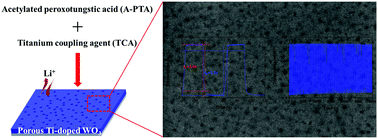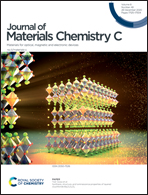Synergistic effects of Ti-doping induced porous networks on electrochromic performance of WO3 films†
Abstract
In this study, amorphous Ti-doped WO3 films with interpenetrated porous networks were successfully fabricated via a facile sol–gel method by using a hydrolysis-tolerant titanium coupling agent (TCA) as a Ti-dopant. We found that the TCA played multiple roles in forming electrochromic WO3 films. First, introducing a TCA into an acetylated peroxotungstic acid (A-PTA) precursor sol was found to prolong the shelf life, which is crucial for practical application. Second, the TCA also acted as a pore-forming agent to form an inter-penetrated porous network in the resultant amorphous WO3 films by annealing at 250 °C. Finally, the TCA generated a higher degree of oxygen vacancy in WO3 films than that in pure WO3 films. Combining all these properties, 8 wt% TCA-doped WO3 films exhibit much larger optical contrast, a faster switching speed and a higher coloration efficiency compared with the corresponding neat WO3 film. The superior electrochromic performances of the TCA-doped WO3 film were attributed to the synergistic effects of the porous structure and oxygen vacancies on the WO3 film, which facilitate the charge-transfer and promote the electrolyte infiltration.



 Please wait while we load your content...
Please wait while we load your content...